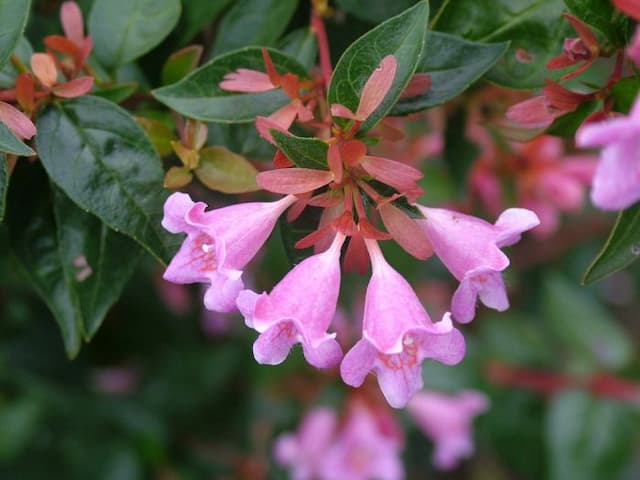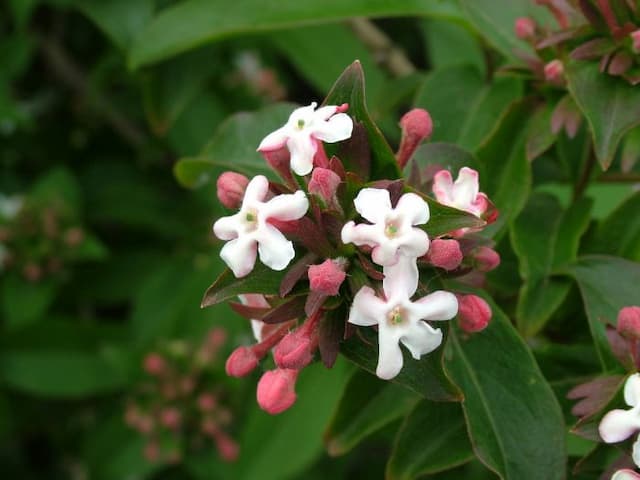Engler's abelia Abelia engleriana

ABOUT
The plant, known by its common name Engler's abelia, showcases a delicate and ornamental appearance that is befitting of its use in decorative gardens. It features an array of small, tubular flowers, which tend to be pale pink to white, that give off a gentle fragrance and attract a variety of pollinators. These blossoms stand out against the plant's backdrop of glossy, oval-shaped leaves, which typically exhibit a bright green color that can turn to purplish-bronze tones in cooler weather. The flowers of Engler's abelia are set in clusters, creating a charming display that lasts from late spring well into the fall. The foliage is semi-evergreen, meaning that depending on the local climate, it may retain its leaves throughout the year or shed them as winter approaches. Engler's abelia branches tend to arch gracefully, giving the plant a somewhat rounded habit. The stems themselves are slender and may have a reddish tinge, adding further visual interest. As a result of its beautiful features and general hardiness, this plant is often chosen for use in residential landscapes to add aesthetic appeal and support local ecology.
About this plant
 Names
NamesSynonyms
Engler's Abelia, Chinese Abelia.
Common names
Abelia coreana, Abelia engleriana var. coreana.
 Toxicity
ToxicityTo humans
Abelia engleriana, commonly known as just Abelia, is generally not considered toxic to humans. There is no prominent information available regarding the plant being poisonous or causing adverse effects if ingested by humans. As with any plant material, individual sensitivities may vary, and it is always advisable to avoid eating plants not explicitly grown for consumption, but typical reactions are not expected with this plant.
To pets
Abelia engleriana, known commonly as Abelia, is not known to be toxic to pets such as dogs and cats. There are no significant reports of toxicity related to pets ingesting this plant. As a precaution, it's always best to prevent pets from eating ornamental plants as individual reactions can vary, but Abelia typically does not pose a risk of poisoning to pets.
 Characteristics
CharacteristicsLife cycle
Perennials
Foliage type
Deciduous
Color of leaves
Green
Flower color
White
Height
3-4 feet (0.9-1.2 meters)
Spread
3-4 feet (0.9-1.2 meters)
Plant type
Shrub
Hardiness zones
6
Native area
China
Benefits
 General Benefits
General Benefits- Ornamental appeal: Abelia engleriana is known for its attractive foliage and clusters of tubular flowers, which add aesthetic value to gardens and landscapes.
- Habitat for wildlife: The flowers provide nectar for pollinators such as bees and butterflies, while the dense foliage offers shelter to various small birds and mammals.
- Low maintenance: Abelia engleriana is generally a low-maintenance plant, requiring minimal pruning and care once established, making it suitable for gardeners of all skill levels.
- Drought tolerance: After it establishes a strong root system, the plant is relatively drought-tolerant, making it a good choice for gardens in arid regions or for xeriscaping.
- Versatility in landscaping: Abelia engleriana can be used in a variety of landscaping applications, including as a hedge, foundation plant, or part of a mixed border.
- Seasonal interest: The plant offers visual interest across multiple seasons, with blossoming flowers typically in the warmer months and evergreen or semi-evergreen foliage providing winter color in mild climates.
- Easy propagation: It can be easily propagated through cuttings, allowing gardeners to expand their plantings without additional cost.
 Medical Properties
Medical PropertiesThis plant is not used for medical purposes.
 Air-purifying Qualities
Air-purifying QualitiesThis plant is not specifically known for air purifying qualities.
 Other Uses
Other Uses- Abelia engleriana, commonly known as Engler's abelia, can be used in bonsai cultivation due to its attractive foliage and the ease with which it can be shaped and maintained in miniature form.
- The plant's dense growth habit makes it suitable for use as a privacy screen or hedge in garden landscapes.
- Its flowers can be used in casual floral arrangements, bringing a touch of the garden's natural beauty indoors.
- Engler's abelia's wood may be used for crafting small wooden objects like garden stakes, due to its firm and resilient nature.
- The fibrous bark of the plant can be used in natural textile creations, although this is not a common application.
- Because of its habitat in woodland edges, Engler's abelia can be used in reforestation projects to help restore natural ecosystems.
- The shrub can be planted to provide shelter and habitat for wildlife, including birds and beneficial insects.
- During fall, the leaves of Engler's abelia change color, making it a valuable plant for ornamental purposes in gardens that emphasize seasonal foliage.
- The plant can be used in noise reduction strategies in landscaping due to its dense growth when planted in mass.
- Its blossoms can be a source of nectar for domesticated bees, supporting local apiculture.
Interesting Facts
 Feng Shui
Feng ShuiThe plant Engler's abelia is not used in Feng Shui practice.
 Zodiac Sign Compitability
Zodiac Sign CompitabilityThe plant Engler's abelia is not used in astrology practice.
 Plant Symbolism
Plant Symbolism- Adaptability: Abelia engleriana, given its ability to thrive in various conditions, often symbolizes the ability to adapt and flourish in different environments.
- Grace: With its graceful arching branches and delicate flowers, this plant represents the quality of grace and elegance.
- Persistence: Known for its long blooming period, Abelia engleriana can symbolize the trait of persistence and enduring effort.
- Abundance: The prolific nature of its blooming can represent abundance and generousness in life or in specific situations.
 Water
WaterFor the Engler's Abelia, regular watering is important, especially during extended periods of drought or heat. Typically, you should provide about 1 inch of water per week, but be sure to adjust based on rainfall and temperature conditions. It's best to water deeply and infrequently to encourage deep root growth. During the growing season, increase the amount slightly but always check the soil moisture to ensure you're not overwatering; the top few inches of soil should dry out between watering. In winter, reduce watering as the plant’s water needs decrease.
 Light
LightEngler's Abelia thrives in full sun to partial shade conditions. The ideal spot for this plant is somewhere it can receive at least 6 hours of direct sunlight daily, though it can tolerate some light shade, especially in hotter climates. Too much shade can lead to fewer flowers and a less dense habit.
 Temperature
TemperatureEngler's Abelia prefers temperate climates with temperatures ranging from around 60°F to 85°F for optimal growth. It can survive minimum temperatures in the winter down to about 5°F. Make sure to protect the plant from strong, cold winter winds which can cause damage to the foliage.
 Pruning
PruningPruning Engler's Abelia helps to maintain its shape and encourage bushier growth. Prune in late winter or early spring before new growth begins. Removing about one-third of the oldest stems each year will encourage rejuvenation. Pruning can also be done after flowering to shape the plant and remove any dead or damaged branches.
 Cleaning
CleaningAs needed
 Soil
SoilEngler's abelia prefers well-drained, humus-rich soil with a pH between 5.5 to 7.5. A recommended soil mix for this plant would be a combination of peat, compost, perlite, and garden soil, which ensures proper drainage and fertility for optimal growth.
 Repotting
RepottingEngler's abelia does not need to be repotted frequently. Repotting every 2 to 3 years is sufficient to refresh the soil and to accommodate root growth. Spring is the best time to repot this plant.
 Humidity & Misting
Humidity & MistingEngler's abelia thrives in moderate to high humidity levels. It is adaptable to average home humidity but benefits from increased humidity, especially if the indoor air is dry. Providing a humidity level of around 40-50% is ideal for this plant.
 Suitable locations
Suitable locationsIndoor
Engler's abelia plant - provide well-drained soil, ample light, maintain moderate humidity.
Outdoor
Plant Engler's abelia in well-drained soil, full sun to part shade.
Hardiness zone
6-9 USDA
 Life cycle
Life cycleAbelia engleriana, commonly known as Engler's abelia, begins its life cycle as a seed, which upon finding suitable conditions, germinates and produces a small seedling. The seedling then grows into a young plant, developing a root system and foliage through photosynthesis. As it matures, Engler's abelia enters a vegetative state where it focuses on growing larger and more robust, with branching stems and leaves. Following the vegetative stage, it enters the reproductive phase, producing fragrant flowers that attract pollinators for sexual reproduction. After pollination, flowers develop into fruit that contains seeds, completing the life cycle when these seeds are dispersed by various means, potentially growing into new plants if the conditions are suitable. Throughout its life, Engler's abelia may face cycles of dormancy and regrowth, particularly in response to seasonal changes in temperate climates.
 Propogation
PropogationPropogation time
Spring-summer
The best time to propagate Abelia engleriana, commonly known as the Engler abelia, is typically in late spring to early summer when the plant is actively growing. The most popular method is softwood cuttings, where new growth that is not yet firm is cut from the plant. Cuttings should be about 4 to 6 inches long, with the lower leaves removed. The cut end of the cutting can then be dipped in a rooting hormone to encourage root development and planted in a well-draining soil mix. The soil should be kept moist, but not waterlogged, and the cuttings should be placed in a warm location with indirect light. With proper care, roots should develop within several weeks, after which the new plants can be gradually acclimated to direct sunlight and eventually transplanted outdoors.







![Himalayan honeysuckle [Golden Lanterns]](/_next/image?url=https%3A%2F%2Fplants-admin.emdemapps.com%2Fimages%2Fplants%2F%2Fimages%2F604b55302cc87.png&w=640&q=75)

